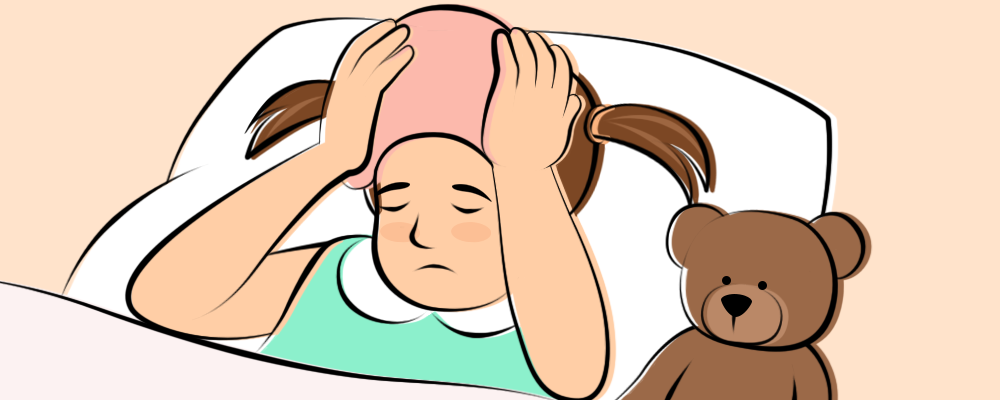It isn’t just adults that get migraines. Kids can get them too. Migraine occurs in about 3-10% of children and that prevalence increases throughout childhood and into adolescence. It is estimated that around 20% of teens get migraines.
Migraine in children affects boys and girls equally in the younger years, but when puberty hits it becomes more common in girls than in boys.
Fortunately, many kids grow out of migraines and their symptoms go away before puberty. However, that isn’t always the case. And if the migraines begin during adolescence, they are even more likely to stick around through adulthood.
Migraine in children often goes untreated because kids have a hard time understanding and describing what is going on. This means that their complaints and their symptoms are not always taken seriously.
But migraines can cause major issues for the children who experience them. The symptoms can disrupt school and home life, leading to missed school, low academic performance, and impaired emotional functioning. They can even lead to depression, anxiety, or sleep disorders.
If you suspect that your child may be getting migraines, it is important to pay attention and help them get the help they need to feel better.
How do I know if my child has migraine?
It can be difficult to know when a child has a migraine. Not all children will be able to fully understand what is going on or have the language to describe their symptoms.
And on top of that, the younger a child is the more atypical the symptoms can be. This means that your child might not feel the characteristic head pain of a classic migraine. Their symptoms might present as something like abdominal pain or dizziness instead. These atypical presentations of migraine symptoms in children can make it confusing for both child and parent to identify a migraine attack when it is happening.
That being said, there are some common symptoms of migraine in children to look out for.
Common symptoms of migraine in children
- Headache, usually on both sides of the head
- Pain of throbbing or pounding quality
- Nausea
- Vomiting
- Pallor
- Sensitivity to light and sound
- Abdominal discomfort or pain
These are similar to some of the symptoms that an adult will get when they have a migraine. However, there are some differences in how migraine presents in children compared to adults. In adults, the pain often felt on one side of the head, whereas in kids it is usually felt on both sides. Migraine attacks in children are also usually shorter in duration than those in adults.
The list above includes some of the most common and basic migraine symptoms in children. But there are also other, less obvious symptoms to watch out for.
Other signs and symptoms of migraine in children
- Weakness on one side
- Confusion
- Speech problems
- Vertigo (attacks of dizziness)
- Torticollis (head tilt to one side)
- Cyclical vomiting
- Abdominal migraine (pain in the belly that usually lasts 1-2 hours)
Conditions like cyclical vomiting, abdominal migraine, and even motion sickness are often related to childhood migraine.
These things often arise and show themselves before kids start to develop migraines. So if your child has had a history of things like car sickness, cyclical vomiting, or pain in the abdomen in the past, this might clue you in that their current symptoms may be related to migraine.
Does your child have a migraine aura?
The majority of children do not have an aura with their migraine, but some kids do. An aura is a collection of symptoms that come on before the actual migraine attack, like warning signs that the headache is coming.
Signs of an aura in children might include:
- Seeing zig-zag lines
- Having blurred vision
- Feeling pinpricks moving down the arms and legs
- Having difficulty speaking clearly
If your child has migraine with aura, these signs can help warn you of oncoming attacks so that you can take precautionary measures and treat the attack quickly.
The bottom line on symptoms
It is important to remember that the younger your child is, the less their symptoms may resemble a classic migraine attack. In younger children, it is more common to see gastrointestinal symptoms like vomiting and stomach pain. As your child ages, the symptoms will likely look more like an adult migraine.
Again, not all children will be able to describe the symptoms listed above. They may just become quiet or pale. Or they may cry, rock, or hide – not being able to tell you where it hurts or what is wrong.
Paying attention to these warning signs can be key in identifying migraine attacks that may not be as easy to see on the surface.
Diagnosing migraine in children
Because children don’t always know how to describe what is happening, diagnosis of childhood migraine can be very difficult.
Consult with your pediatrician if you believe your child is exhibiting signs of migraine.
Your doctor will likely want to know things such as:
- How does it feel before, during, and after the headache?
- Where does the pain occur?
- When and how often do the attacks happen?
- How long do they last?
- What symptoms are present?
- What helps make it feel better, and what makes it feel worse?
- Do changes in position make the pain worse?
- Do you know of any triggers?
- Are there warning signs that a headache is coming?
- Have you noticed changes in behavior patterns, personality, or walking?
- Is your child having trouble sleeping?
To aid in the process, it is helpful to keep a detailed diary of your child’s headaches and symptoms. This will help you come to your appointment prepared to answer questions and provide your pediatrician with all the information they need come to a proper diagnosis.
In many cases, if the health history is consistent with migraine, then your child won’t need any more diagnostic testing. But your doctor may order blood tests, an MRI, a CT scan, or a sleep study to confirm their diagnosis.
Causes of migraine in children
If your child is diagnosed with migraine, then it will help you to know what can trigger migraine in children.
Common migraine triggers in children
- Stress
- Lack of sleep
- Changes in eating patterns
- Certain foods
- Weather changes
- Dehydration
- Travel (and motion sickness)
- Menstruation (for adolescents)
- Changes in routine
Often, it is things like skipping a meal or not drinking enough water that can cause a migraine. Changes in routine, like staying up too late or being in a new environment, can also be an issue.
Stress (either positive or negative) is a very common trigger for kids. For example, a test at school or an exciting event that the child anticipates could bring on a migraine.
Again, keeping a migraine diary is key. This will help you start to identify possible triggers that may be affecting your child. Along with their symptoms, keep note of the foods your child eats, their sleep schedule, variations in routine, and anything else you can think of.
How to treat migraine in children
If your child is getting migraines, then it is important to act quickly and find a treatment plan that helps you manage the condition and reduce their discomfort as much as possible. Proper treatment can prevent issues that come along with recurrent attacks such as emotional distress, missed school, or sleep problems.
Work with your pediatrician to determine the best plan of action.
The migraine treatment plan will be based off of many factors, including your child’s age; the frequency and severity of the headaches; the child’s tolerance of medications, procedures, and therapies; and your personal preferences as a family.
Treating migraines in children usually begins with at-home, over-the-counter options. If that doesn’t work, doctors may prescribe medications to take when an attack occurs. And for hard-to-manage cases, treatment may involve preventative medications. Finally, there are integrative treatment options that you may choose to pursue.
Things you can do at home
First, there are things you can do at home to help comfort and soothe your child during an attack.
The most effective include:
- Letting the child sleep in a dark, quiet, cool room. Sleep is often the best way to get rid of a migraine.
- Giving your child pain relievers like ibuprofen or acetaminophen.
- Being present and comforting the child.
- Putting ice on the head.
- Keeping them hydrated and fed with soothing foods.
Medications to take during an attack
If at-home approaches aren’t enough to ease symptoms, your doctor may suggest prescription medications that your child can take during an attack to feel better.
Medications called triptans may be used in older children to stop migraine symptoms. These are called “abortive medications” and are designed to be taken at the first sign of an attack. They are not usually suggested for use in younger children.
Your child may also be prescribed an anti-emetic to treat vomiting or a sedative to help them sleep.
Preventative medications
If your child is still suffering a lot and has recurrent migraine attacks, preventative options may be considered. There are several different medications that can be taken daily in the hopes of preventing migraines from occurring in the first place.
Amitriptyline, Topamax, gabapentin, propranolol, antihistamines, and beta blockers are all examples of preventative medications.
Integrative options
You may opt to work with a wide variety of healthcare practitioners in your search for a treatment plan that works for your child. Many people consult with nutritionists, psychologists, acupuncturists, herbal medicine practitioners, physical therapists, and more.
Lifestyle and prevention
Shifting daily habits and making some simple lifestyle changes can help you support your child’s health and prevent attacks from occurring in the first place.
Here are some things that can help your child:
- Staying hydrated
- Having consistent food intake
- Sleeping regularly
- Exercising and being active regularly
- Keeping a regular routine
- Not overscheduling or being too busy
- Managing stress
That last one is of particular importance. Stress is a major childhood migraine trigger. Many children find themselves under a lot of stress to excel in school and extracurricular activities. If this sounds like your child, then helping them learn to manage their stress better can be key to dealing with migraines.
Trying out meditation, using mindfulness tools, or working with a therapist may be helpful. Biofeedback therapy is a good option for children, which is a tool that helps them understand the stress response and how to reduce its effect on the body.
Conclusion
It is always hard to watch your children when they are in pain or are suffering. Migraines are no exception. So make a plan of action so that allows you and your child to manage this condition the best that you can.
And remember, there is a lot that you can do to help just by making some changes to the family routines. Support healthy habits like eating well, avoiding triggers, keeping regular routines, and managing stress to help prevent migraines from occurring in the first place.




